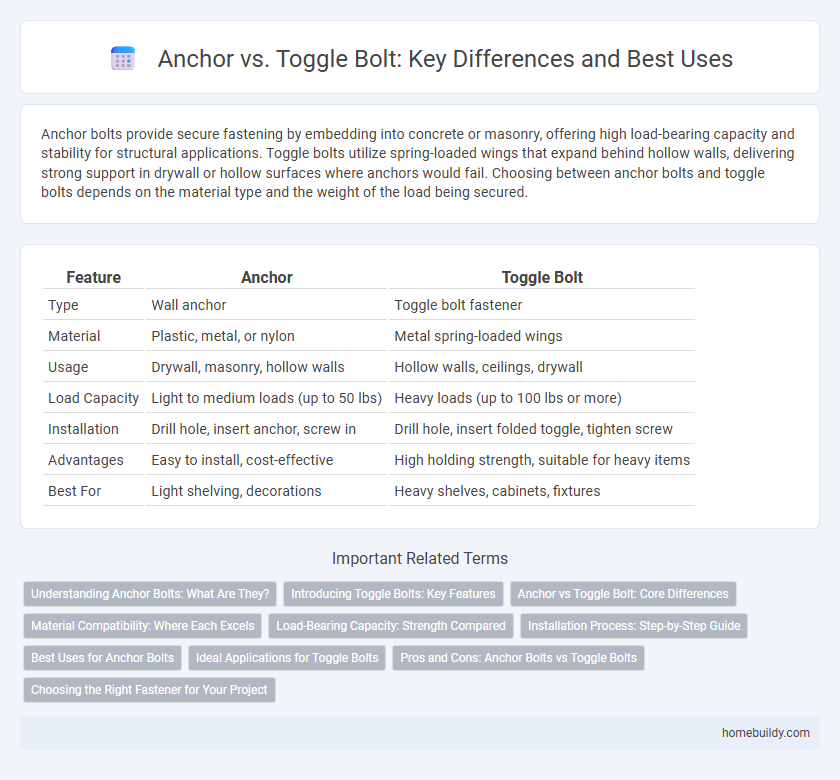Anchor bolts provide secure fastening by embedding into concrete or masonry, offering high load-bearing capacity and stability for structural applications. Toggle bolts utilize spring-loaded wings that expand behind hollow walls, delivering strong support in drywall or hollow surfaces where anchors would fail. Choosing between anchor bolts and toggle bolts depends on the material type and the weight of the load being secured.
Table of Comparison
| Feature | Anchor | Toggle Bolt |
|---|---|---|
| Type | Wall anchor | Toggle bolt fastener |
| Material | Plastic, metal, or nylon | Metal spring-loaded wings |
| Usage | Drywall, masonry, hollow walls | Hollow walls, ceilings, drywall |
| Load Capacity | Light to medium loads (up to 50 lbs) | Heavy loads (up to 100 lbs or more) |
| Installation | Drill hole, insert anchor, screw in | Drill hole, insert folded toggle, tighten screw |
| Advantages | Easy to install, cost-effective | High holding strength, suitable for heavy items |
| Best For | Light shelving, decorations | Heavy shelves, cabinets, fixtures |
Understanding Anchor Bolts: What Are They?
Anchor bolts are heavy-duty fasteners embedded in concrete or masonry to secure structures and equipment, providing reliable load resistance and stability. They come in various types, including expansion anchors, epoxy anchors, and wedge anchors, each designed to perform under specific load conditions and materials. Understanding the specific application and load requirements is crucial when selecting anchor bolts to ensure safety and structural integrity.
Introducing Toggle Bolts: Key Features
Toggle bolts are heavy-duty fasteners designed for securing objects to hollow walls, such as drywall or plaster. Featuring spring-loaded wings that open inside the cavity, they provide a strong hold by distributing weight over a larger surface area. These bolts are ideal for mounting heavy items like shelves, mirrors, and cabinets where standard anchors may fail.
Anchor vs Toggle Bolt: Core Differences
Anchors provide strong holding power in solid materials like concrete or brick by expanding within the substrate, while toggle bolts excel in hollow walls by deploying wings that spread the load over a larger area behind the surface. Anchors are ideal for heavy-duty applications requiring high shear strength, whereas toggle bolts offer superior pull-out resistance in drywall or hollow spaces. The choice between anchor and toggle bolt depends on wall type, load requirements, and installation conditions.
Material Compatibility: Where Each Excels
Anchor bolts excel in securing materials like concrete, brick, and stone due to their strong expansion mechanism that grips firmly within solid substrates. Toggle bolts perform best in hollow wall applications, such as drywall or plaster, where their spring-loaded wings distribute weight across a larger area to prevent pull-through. The material compatibility of anchor bolts favors dense, load-bearing surfaces, while toggle bolts are ideal for lightweight or hollow materials that cannot support traditional anchors.
Load-Bearing Capacity: Strength Compared
Anchor bolts provide a high load-bearing capacity by embedding deeply into concrete or masonry, offering superior strength for heavy structural applications. Toggle bolts distribute weight across a wider area behind drywall, making them ideal for medium loads but less effective for high-strength demands. Comparing load-bearing capacity, anchor bolts outperform toggle bolts in supporting heavy weights, especially in solid materials.
Installation Process: Step-by-Step Guide
To install an anchor, drill a pilot hole, insert the anchor, and then drive the screw into it for a secure hold in drywall or masonry. For a toggle bolt, drill a hole large enough for the folded toggle, insert the toggle through the hole, and tighten the screw while the toggle wings expand behind the wall for strong support. Both methods require precise hole sizing and careful tightening to prevent wall damage and ensure stability.
Best Uses for Anchor Bolts
Anchor bolts are best used for securing heavy loads to concrete or masonry surfaces, providing superior pull-out strength and structural stability. They excel in applications like attaching steel columns, light poles, and large machinery where precise load transfer is critical. Unlike toggle bolts, anchor bolts offer permanent, high-strength fastening ideal for exterior and load-bearing projects.
Ideal Applications for Toggle Bolts
Toggle bolts are ideal for securing heavy objects to hollow walls like drywall or plaster, where traditional anchors cannot provide adequate support. They expand behind the wall, distributing weight over a larger area, making them suitable for mounting shelves, cabinets, and large mirrors. Their design ensures a strong hold in spaces lacking a stud, preventing damage and ensuring stability.
Pros and Cons: Anchor Bolts vs Toggle Bolts
Anchor bolts offer superior load-bearing capacity in solid materials like concrete and masonry, providing strong, permanent holds ideal for structural applications. Toggle bolts excel in hollow walls such as drywall, distributing weight over a broader area to prevent pull-through but may not support as heavy loads as anchor bolts. While anchor bolts require drilling into solid substrates, toggle bolts are easier to install in inaccessible cavities but can loosen over time under vibration or heavy stress.
Choosing the Right Fastener for Your Project
Choosing the right fastener between an anchor and a toggle bolt depends on the weight and material of the surface to be secured. Anchors are ideal for medium loads in drywall or masonry, providing reliable grip without excessive installation complexity. Toggle bolts offer superior strength for heavier loads in hollow walls, distributing weight through expanding wings for maximum support.
Anchor vs Toggle Bolt Infographic

 homebuildy.com
homebuildy.com